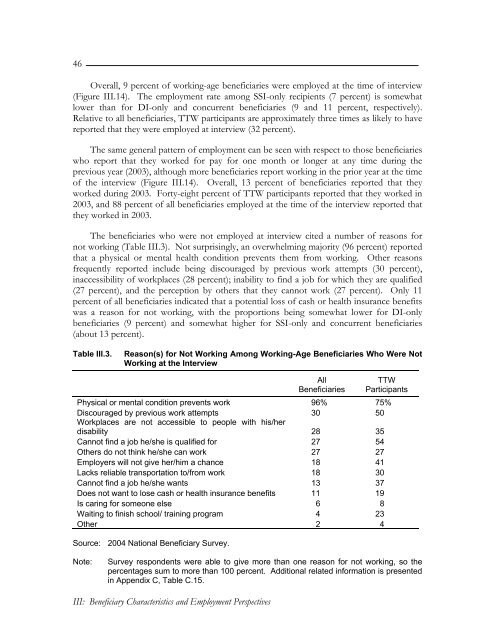Evaluation of the Ticket to Work Program, Implementation ...
Evaluation of the Ticket to Work Program, Implementation ...
Evaluation of the Ticket to Work Program, Implementation ...
Create successful ePaper yourself
Turn your PDF publications into a flip-book with our unique Google optimized e-Paper software.
46Overall, 9 percent <strong>of</strong> working-age beneficiaries were employed at <strong>the</strong> time <strong>of</strong> interview(Figure III.14). The employment rate among SSI-only recipients (7 percent) is somewhatlower than for DI-only and concurrent beneficiaries (9 and 11 percent, respectively).Relative <strong>to</strong> all beneficiaries, TTW participants are approximately three times as likely <strong>to</strong> havereported that <strong>the</strong>y were employed at interview (32 percent).The same general pattern <strong>of</strong> employment can be seen with respect <strong>to</strong> those beneficiarieswho report that <strong>the</strong>y worked for pay for one month or longer at any time during <strong>the</strong>previous year (2003), although more beneficiaries report working in <strong>the</strong> prior year at <strong>the</strong> time<strong>of</strong> <strong>the</strong> interview (Figure III.14). Overall, 13 percent <strong>of</strong> beneficiaries reported that <strong>the</strong>yworked during 2003. Forty-eight percent <strong>of</strong> TTW participants reported that <strong>the</strong>y worked in2003, and 88 percent <strong>of</strong> all beneficiaries employed at <strong>the</strong> time <strong>of</strong> <strong>the</strong> interview reported that<strong>the</strong>y worked in 2003.The beneficiaries who were not employed at interview cited a number <strong>of</strong> reasons fornot working (Table III.3). Not surprisingly, an overwhelming majority (96 percent) reportedthat a physical or mental health condition prevents <strong>the</strong>m from working. O<strong>the</strong>r reasonsfrequently reported include being discouraged by previous work attempts (30 percent),inaccessibility <strong>of</strong> workplaces (28 percent); inability <strong>to</strong> find a job for which <strong>the</strong>y are qualified(27 percent), and <strong>the</strong> perception by o<strong>the</strong>rs that <strong>the</strong>y cannot work (27 percent). Only 11percent <strong>of</strong> all beneficiaries indicated that a potential loss <strong>of</strong> cash or health insurance benefitswas a reason for not working, with <strong>the</strong> proportions being somewhat lower for DI-onlybeneficiaries (9 percent) and somewhat higher for SSI-only and concurrent beneficiaries(about 13 percent).Table III.3.Reason(s) for Not <strong>Work</strong>ing Among <strong>Work</strong>ing-Age Beneficiaries Who Were Not<strong>Work</strong>ing at <strong>the</strong> InterviewAllBeneficiariesTTWParticipantsPhysical or mental condition prevents work 96% 75%Discouraged by previous work attempts 30 50<strong>Work</strong>places are not accessible <strong>to</strong> people with his/herdisability 28 35Cannot find a job he/she is qualified for 27 54O<strong>the</strong>rs do not think he/she can work 27 27Employers will not give her/him a chance 18 41Lacks reliable transportation <strong>to</strong>/from work 18 30Cannot find a job he/she wants 13 37Does not want <strong>to</strong> lose cash or health insurance benefits 11 19Is caring for someone else 6 8Waiting <strong>to</strong> finish school/ training program 4 23O<strong>the</strong>r 2 4Source: 2004 National Beneficiary Survey.Note:Survey respondents were able <strong>to</strong> give more than one reason for not working, so <strong>the</strong>percentages sum <strong>to</strong> more than 100 percent. Additional related information is presentedin Appendix C, Table C.15.III: Beneficiary Characteristics and Employment Perspectives
















